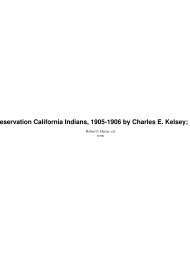The Geography and Dialects of the Miwok Indians - Yosemite Online
The Geography and Dialects of the Miwok Indians - Yosemite Online
The Geography and Dialects of the Miwok Indians - Yosemite Online
You also want an ePaper? Increase the reach of your titles
YUMPU automatically turns print PDFs into web optimized ePapers that Google loves.
1908] Barrett .—<strong>The</strong> <strong>Geography</strong> <strong>and</strong> <strong>Dialects</strong> <strong>of</strong> <strong>the</strong> <strong>Miwok</strong> <strong>Indians</strong> . 341<br />
in <strong>the</strong> names applied to <strong>the</strong> people <strong>of</strong> <strong>the</strong> villages, respectively<br />
Otceha'mni <strong>and</strong> moke'lumni, signifying in full, people <strong>of</strong> O'tce or<br />
O'tcex <strong>and</strong> people <strong>of</strong> mO'kel . Notwithst<strong>and</strong>ing <strong>the</strong> obvious similarity<br />
between <strong>the</strong>se <strong>and</strong> <strong>the</strong> Yokuts tribal names, <strong>the</strong>re is an essential<br />
difference between <strong>the</strong> two . Whereas <strong>the</strong> Yokuts tribal name<br />
with its -umni ending appears to be very strictly applied to <strong>the</strong><br />
people <strong>the</strong>mselves <strong>of</strong> a certain community, it was quite independent<br />
<strong>of</strong> <strong>the</strong> name <strong>of</strong> <strong>the</strong> village in which <strong>the</strong>y lived . For instance,<br />
<strong>the</strong> Choinimni now live at tice'ten in <strong>the</strong> edge <strong>of</strong> <strong>the</strong> foot-hills on<br />
King's river. Fur<strong>the</strong>r, <strong>the</strong>se tribal names are a part <strong>of</strong> <strong>the</strong> inheritance<br />
<strong>of</strong> <strong>the</strong> individual, <strong>and</strong> attach to <strong>the</strong> person belonging<br />
to <strong>the</strong> tribe no matter where he may be or how far he may move<br />
from <strong>the</strong> home <strong>of</strong> <strong>the</strong> remainder <strong>of</strong> his tribe . On <strong>the</strong> o<strong>the</strong>r<br />
h<strong>and</strong>, <strong>the</strong> <strong>Miwok</strong> employed such names as moke'lumni entirely<br />
with <strong>the</strong> signification <strong>of</strong> "people <strong>of</strong>" <strong>the</strong> village <strong>of</strong> mo'kel ; <strong>and</strong><br />
should an individual permanently change his residence to O'tcex,<br />
he would <strong>the</strong>n be referred to as an Otceha'mni, <strong>the</strong> idea being that<br />
when he changes his place <strong>of</strong> actual residence he loses all connection<br />
with <strong>the</strong> name by which he has formerly been known.<br />
In this respect <strong>the</strong> <strong>Miwok</strong> resemble most if not all <strong>of</strong> <strong>the</strong> peoples<br />
<strong>of</strong> central <strong>and</strong> nor<strong>the</strong>rn California, except <strong>the</strong> Yokuts.<br />
<strong>The</strong> only general names applied to people by <strong>the</strong> <strong>Miwok</strong> were<br />
terms formed upon <strong>the</strong> names <strong>of</strong> <strong>the</strong> cardinal points . Examples<br />
<strong>of</strong> such names are : ta'mnlekO, nor<strong>the</strong>rners, from ta'man or tama'-<br />
lin, north ; hi sotoko, easterners, from hi sum, east ; tcu'metoko,<br />
sou<strong>the</strong>rners, from tcn'metc, south ; <strong>and</strong> olowitoko, westerners,<br />
from olo'win, west . This ending, which is equivalent to "people<br />
<strong>of</strong>," takes <strong>the</strong> following forms : oko, ok, k. That <strong>the</strong>se names<br />
have no tribal signification is clearly shown by <strong>the</strong> fact that each<br />
is applied not to any particular people but to all people, no matter<br />
how near or remote, living in <strong>the</strong> given direction to which <strong>the</strong><br />
name refers. <strong>The</strong>se names, as also <strong>the</strong> terms applied to <strong>the</strong> cardinal<br />
points, vary according to <strong>the</strong> laws <strong>of</strong> phonetic change in<br />
passing from one dialect to ano<strong>the</strong>r. <strong>The</strong>re are also certain different<br />
endings used by different individuals speaking <strong>the</strong> same<br />
dialect. For example : <strong>the</strong> people living to <strong>the</strong> south are called<br />
tcn'metoko, tcu'mmetok, <strong>and</strong> tcumte'ya, those to <strong>the</strong> east are<br />
called hi sotoko <strong>and</strong> hisu wit . In <strong>the</strong> last term <strong>the</strong> ending -wit is<br />
really a directive with <strong>the</strong> signification <strong>of</strong> towards .




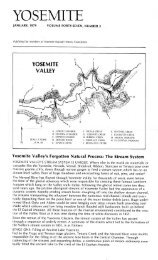
![(March 1982) [PDF] “We Are Pleased to Announce†- Yosemite Online](https://img.yumpu.com/51299748/1/190x242/march-1982-pdf-aeuroewe-are-pleased-to-announceaeur-yosemite-online.jpg?quality=85)
![[PDF] Old Horny, Yosemite's Unicorn Buck - Yosemite Online](https://img.yumpu.com/51269869/1/184x260/pdf-old-horny-yosemites-unicorn-buck-yosemite-online.jpg?quality=85)
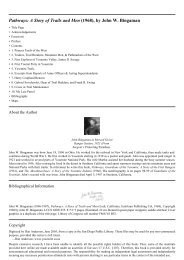
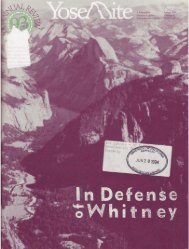
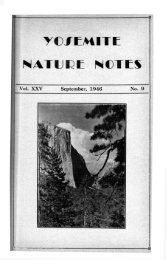
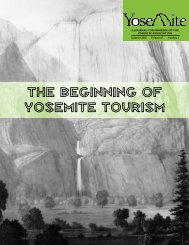
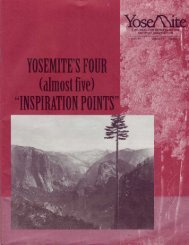
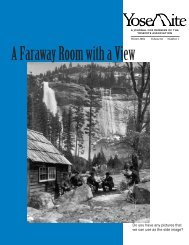
![1985 [PDF] - Yosemite](https://img.yumpu.com/48128837/1/184x260/1985-pdf-yosemite.jpg?quality=85)

